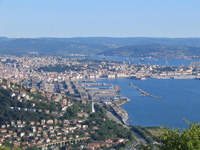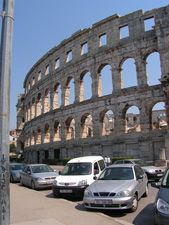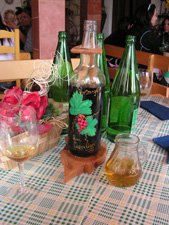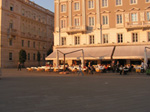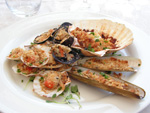Note: Faculty member Keith Clarke and his wife Margot are currently on sabbatical in Trieste, Italy, supported by a Fulbright Distinguished Chair.
Last winter, on the verge of finishing my Leverhulme fellowship residence in London, I promised to send a second sabbatical update. Well, spring is here, and here I am in Trieste, having arrived not by the mysterious Orient Express but by the plenty-less-than-glamorous Ryan Air. I’m a Fulbright Distinguished Chair in residence in the Dipartimento di Scienze Geografiche e Storiche at the Universita di Trieste. Take a look at a map of Italy, noticing the familiar boot (stivale), kicking the ball (Sicilia) into the soccer goal (Sardinia). Imagine that the boot ties at the back: Trieste is the tip of the boot lace dangling out east toward central Europe. We’re closer to Ljubljana, capital of Slovenia, than to Venice, the nearest large city in Italy. Trieste is squeezed onto a narrow strip of land on the Adriatic side of the limestone mountains called Carsto in Italy, and Krst in Slovenia.
Trieste is a city at the geographic edge in both the physical and cultural meanings. First settled in prehistoric times, it was colonized by the Romans who built a great city and theater here in the first century AD. Later came mercantile colonization from the maritime Kingdom of Venice, whose sea captains fought and defeated the Turks in the Adriatic. In medieval times came castles to defend against the Serbs, Croats, and Slovenians. When Venice fell to Napoleon in 1801, Trieste remained with the Austro-Hungarian Empire, as it had been since 1525. In the grand era of the “Belle Epoch,” Trieste became Vienna’s outlet to the sea, bringing trade, prosperity, and a massive sea-port that is termed the “third entrance” to the Suez Canal. Archduke Maximilian built a fantasy castle here, called Miramare, but was assassinated in Mexico before he could enjoy it. In World War One, the Italians fought the Austrians to a standstill on the Karst Hills above Trieste. At the conclusion of the war, with the disintegration of Austro-Hungary, Trieste was taken by Italy and saw the rise of Mussolini and eventual occupation by the Nazis. At the end of World War Two, Yugoslavian freedom fighters liberated Trieste from the Nazis just before New Zealand and British troops arrived as an occupation force, eventually replaced by Americans, making it, for a while, a free trade zone. Cut off from its hinterland in Austria and the Adriatic peninsula of Istria, Trieste went into decline. A UN settlement gave Istria to Yugoslavia and Trieste back to Italy, so the Iron Curtain of Cold War fame literally reached the sea a few kilometers east of Trieste. Trieste remained as a border town throughout the war in Bosnia and Serbia, to face change again on January 1st, 2007 when a free Slovenia joined the European Union.
Each of these epochs has left its footprint on the urban geography of Trieste. There are roman walls, viaducts and arches, Venetian palaces and canals, Serbian orthodox cathedrals, Italy’s largest synagogue (but also across town Italy’s only concentration camp), Mussolini architecture (including the University), and block after block of Belle Epoch architecture, baroque statues, museums, and castles. Trieste is also a pedestrian-friendly city, with excellent public buses and superb sidewalk cafes. The people are an extraordinary ethnic mix, and there is a local dialect that is a blend of Slovenian, Serbo-Croatian, and Italian. Margot and I have taken several excursions. The extraordinary Park Skocjanske jame in Slovenia is a UNESCO world heritage site – about 5km of deep karst caves along which flows the Reka-Velka river roaring along a deep underground channel far below a precarious trail hundreds of meters up along the cave wall. I attended a joint Italian-Romanian Geography meeting in Gorizia, a city with a town square that was literally astride the iron curtain. We’ve also taken trips to Venice and Verona and have seen more renaissance art than I knew existed in the world. Another extraordinary trip was with a Geography field class through Istria, visiting the world class medieval and roman towns of Piran, Porec, Rovinj, and Pula, the latter with an arena the size of Rome’s coliseum. Throughout Istria, in both Slovenia and Croatia, there is a new prosperity due to tourism that is growing year by year.
Life as a scholar in Trieste has been very different from Santa Barbara. I’m working on mapping land use change in border towns between Slovenia and Italy using Landsat, Aster, and all the usual GIS trimmings. Morning is lab time, and I use the afternoons for writing. After the world reawakens at about 5pm, we take a downtown passeggiata (stroll) for coffee or Aperol (aperitif) at the Café degli Specchi (Café of the Mirrors) on the Piazza Unita. On weekends there is a beautiful tram ride up the mountain to Opicina, with a trail along the hills to the village of Proseco, followed by pranza (lunch) of shellfish above the beach at Barcola. Life is good here, but my sabbatical is now running toward its completion, and Santa Barbara beckons in mid-June. It has been an amazing year full of new experiences, and one I’ll never forget. Several writers, Italo Svevo, James Joyce, and Jan Morris among them, have described Trieste’s unique character, noting the “edge” character of the city. To understand life at the geographical edge, you’ll just have to visit Trieste for yourself. Ryan Air flies daily from London for very little money, if you can stand discount airlines.


